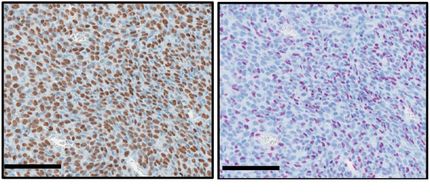Researchers find new insights into inherited retinal disease
An international team of scientists, led by researchers at the University of California, San Diego School of medicine have discovered new links between a common form of inherited blindness affecting children and a gene known as Abelson helper integration site-1 (AHI1). Their findings, which may lead to new therapies and improved diagnostics for retinal disease, will appear in Nature genetics.
A newly recognized class of disease known as "ciliopathies" has caught the attention of the medical community. Ciliopathies are caused by problems in the structure and/or function of cilia, which are small antenna-like structures protruding from the surface of most cells.
The function of cilia has not been understood, but patients with ciliopathies can suffer from a spectrum of problems including retinal blindness, obesity, renal failure, liver fibrosis and mental impairment. Major breakthroughs in the past few years have linked many forms of these diseases with defects in the structure or signaling capacity of the cilia in cells as diverse as retinal, fat, kidney, liver and nerve cells. Because cilia are so widely present on cells throughout the body, many seemingly unrelated diseases are now known to be related through functions of cilia.
"We are just beginning to uncover the genetic causes for these disorders, but more research is needed to understand why patients with these particular genetic alterations have such variable diseases," said Joseph G. Gleeson, MD, professor of neurosciences and pediatrics at UC San Diego and Howard Hughes Medical Institute Investigator, who supervised the work.
The scientists, led by Gleeson and UCSD graduate student Carrie M. Louie, discovered that loss of the AHI1 gene, which had already been found to cause Joubert Syndrome, a ciliopathy of mental retardation and impaired balance, also caused severe early onset retinal degeneration in the mouse model that they created. This model resembled the most common form of inherited blindness, which is due to degeneration of the retina at an early age.
Further investigation revealed that retinal photoreceptor cells in the mouse model were most likely dying as a result of a toxic accumulation of the very photopigment that receives light signals in the eye and is crucial for normal vision. This finding sheds light on one of the potential causes of retinal degeneration, protein mis-trafficking, which has been of fundamental interest in the study of inherited blindness, according to Gleeson.
The group then tested whether mutations in genes might contribute to retinal blindness in other related diseases. Their analysis of a group of European patients suggests that this is the case. The scientists found that patients carrying a particular genetic alteration were between five and ten times more likely to have retinal blindness, and that some forms of this blindness may be particularly amenable to gene therapy.
"These results may lead to better screening and future therapies for congenital blindness," said Louie. "As routine sequencing of the human genome becomes more and more feasible, studies like ours will help pinpoint which genetic alterations increase the risk of having a certain disease, or the likelihood that your children will have the disease."
See the theme worlds for related content
Topic world Gene therapy
Genetic diseases once considered untreatable are now at the center of innovative therapeutic approaches. Research and development of gene therapies in biotech and pharma aim to directly correct or replace defective or missing genes to combat disease at the molecular level. This revolutionary approach promises not only to treat symptoms, but to eliminate the cause of the disease itself.

Topic world Gene therapy
Genetic diseases once considered untreatable are now at the center of innovative therapeutic approaches. Research and development of gene therapies in biotech and pharma aim to directly correct or replace defective or missing genes to combat disease at the molecular level. This revolutionary approach promises not only to treat symptoms, but to eliminate the cause of the disease itself.






















































